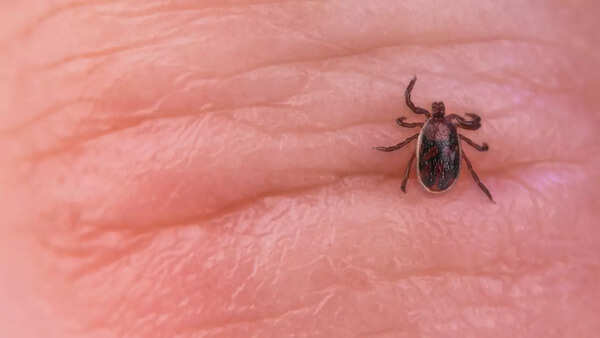Maria Palen, a vibrant 31-year-old chemical engineer from California, embodied the image of a fitness enthusiast. Boasting over 20,000 Instagram followers, she inspired many with her dedication to a clean, plant-based diet and regular exercise. However, her journey took an unexpected turn when she was diagnosed with babesiosis, a parasitic infection transmitted through tick bites, leading to paralysis from the waist down by late 2024.

Image credit: Instagram/planthlete_maria
Maria's story serves as a stark reminder that outward appearances of health can mask underlying battles. More than just a health scare, her experience highlights the often-overlooked dangers of tick-borne illnesses, particularly for those who enjoy outdoor activities.
Initially, Maria experienced mild symptoms such as inflammation, joint discomfort, and thumb pain. Attempting to address these issues naturally, she adjusted her diet and increased her exercise regimen. Unfortunately, her condition deteriorated.
By March 2024, she was largely confined to her bed, struggling with everyday tasks. Eventually, a functional medicine specialist identified babesiosis, a relatively obscure tick-borne disease caused by Babesia parasites that attack red blood cells. Unlike Lyme disease, babesiosis often goes undetected due to its flu-like symptoms. The Centers for Disease Control and Prevention (CDC) reports that babesiosis cases have doubled in the past decade, rising from 1,000 in 2011 to approximately 2,500 annually.
Maria suspects she contracted the infection years prior, possibly during a hike. The undetected tick bite allowed the infection to progress, ultimately affecting her nervous system. By October 2024, severe tailbone pain prevented her from sitting, and paralysis soon followed.
Tick bites are often subtle, painless, and easily missed. Compounding the issue is the potential for infections to remain dormant for extended periods. Maria's case underscores the lack of awareness surrounding lesser-known tick-borne diseases like babesiosis.
Ticks are most active during warmer months, thriving in grassy and wooded environments. The 2024 tick season in the US was particularly severe, with milder winters contributing to increased animal populations that host ticks. Researchers at the University of California, Riverside, warn that this surge in tick populations elevates the risk of rare infections spreading unnoticed.
The microbes responsible for babesiosis (Babesia microti and B. duncani) are difficult to detect as they reside within red blood cells. Recent genomic research on B. duncani reveals similarities to the malaria parasite, explaining symptoms such as fever, chills, and muscle aches that precede more severe complications.

(Pic courtesy: iStock)
Maria's story is not just about adversity; it's about resilience. Despite undergoing extensive therapy, she remains optimistic about regaining mobility in her legs. Her experience emphasizes the importance of early detection.
While Lyme disease is often the primary focus in tick-borne illness testing, babesiosis is frequently overlooked. Furthermore, because it can coexist with Lyme disease, its symptoms may be misattributed. It is crucial for healthcare providers to adopt a broader diagnostic approach, and for individuals to monitor any unexplained changes in energy levels, muscle strength, or chronic pain, particularly after spending time outdoors.
Risks extend beyond hiking and camping. Even gardening or walking through wooded areas can expose individuals to ticks, especially without protective clothing or repellents.
Traditional advice often includes wearing long sleeves and checking for ticks. However, Maria's experience calls for a more comprehensive approach:
[This article is intended for informational purposes only and is not a substitute for professional medical advice. For any symptoms or health concerns, please consult a licensed healthcare provider]
Newer articles
Older articles
 Vijay Officially Named TVK's Chief Minister Hopeful for Tamil Nadu's 2026 Election
Vijay Officially Named TVK's Chief Minister Hopeful for Tamil Nadu's 2026 Election
 RJ Mahvash Prioritizes Work Over Buzz, Addresses Link-Up Speculation
RJ Mahvash Prioritizes Work Over Buzz, Addresses Link-Up Speculation
 Which Chair Would You Choose? This Personality Test Reveals Surprising Insights
Which Chair Would You Choose? This Personality Test Reveals Surprising Insights
 UNESCO's World Heritage Wonders: Unveiling 10 Iconic Sites, From Petra to the Pyramids
UNESCO's World Heritage Wonders: Unveiling 10 Iconic Sites, From Petra to the Pyramids
 JPG to PDF: A Comprehensive Guide for Graphic Designers & Professionals
JPG to PDF: A Comprehensive Guide for Graphic Designers & Professionals
 Shadman Islam Defends Bangladesh Batters After Day 1 Struggles Against Sri Lanka
Shadman Islam Defends Bangladesh Batters After Day 1 Struggles Against Sri Lanka
 iQoo Z9 Turbo: Rumored Specs Emerge – Snapdragon 8s Gen 3, 6000mAh Battery Highlighted
iQoo Z9 Turbo: Rumored Specs Emerge – Snapdragon 8s Gen 3, 6000mAh Battery Highlighted
 Tick Bite Paralyzes Fitness Influencer: A Wake-Up Call for Outdoor Enthusiasts
Tick Bite Paralyzes Fitness Influencer: A Wake-Up Call for Outdoor Enthusiasts
 5 Often-Missed Warning Signs of Bladder Cancer You Need to Know
5 Often-Missed Warning Signs of Bladder Cancer You Need to Know
 KL Rahul Puts Country First, Prioritizes England Tests Over Newborn Child
KL Rahul Puts Country First, Prioritizes England Tests Over Newborn Child